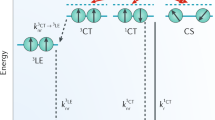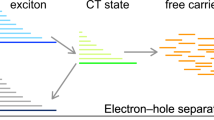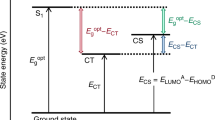Abstract
Intermolecular charge-transfer states at the interface between electron donating (D) and accepting (A) materials are crucial for the operation of organic solar cells but can also be exploited for organic light-emitting diodes1,2. Non-radiative charge-transfer state decay is dominant in state-of-the-art D–A-based organic solar cells and is responsible for large voltage losses and relatively low power-conversion efficiencies as well as electroluminescence external quantum yields in the 0.01–0.0001% range3,4. In contrast, the electroluminescence external quantum yield reaches up to 16% in D–A-based organic light-emitting diodes5,6,7. Here, we show that proper control of charge-transfer state properties allows simultaneous occurrence of a high photovoltaic and emission quantum yield within a single, visible-light-emitting D–A system. This leads to ultralow-emission turn-on voltages as well as significantly reduced voltage losses upon solar illumination. These results unify the description of the electro-optical properties of charge-transfer states in organic optoelectronic devices and foster the use of organic D–A blends in energy conversion applications involving visible and ultraviolet photons8,9,10,11.
This is a preview of subscription content, access via your institution
Access options
Access Nature and 54 other Nature Portfolio journals
Get Nature+, our best-value online-access subscription
$29.99 / 30 days
cancel any time
Subscribe to this journal
Receive 12 print issues and online access
$259.00 per year
only $21.58 per issue
Buy this article
- Purchase on Springer Link
- Instant access to full article PDF
Prices may be subject to local taxes which are calculated during checkout



Similar content being viewed by others
Data availability
The data that support the plots within this paper and other findings of this study are available from the corresponding authors upon reasonable request.
References
Yan, C. et al. Non-fullerene acceptors for organic solar cells. Nat. Rev. Mater. 3, 18003 (2018).
Sarma, M. & Wong, K.-T. Exciplex: an intermolecular charge-transfer approach for TADF. ACS Appl. Mater. Interfaces 10, 19279–19304 (2018).
Benduhn, J. et al. Intrinsic non-radiative voltage losses in fullerene-based organic solar cells. Nat. Energy 2, 17053 (2017).
Qian, D. et al. Design rules for minimizing voltage losses in high-efficiency organic solar cells. Nat. Mater. 17, 703–709 (2018).
Goushi, K., Yoshida, K., Sato, K. & Adachi, C. Organic light-emitting diodes employing efficient reverse intersystem crossing for triplet-to-singlet state conversion. Nat. Photon. 6, 253–258 (2012).
Chen, D. et al. Fluorescent organic planar pn heterojunction light-emitting diodes with simplified structure, extremely low driving voltage, and high efficiency. Adv. Mater. 28, 239–244 (2016).
Lin, T.-C. et al. Probe exciplex structure of highly efficient thermally activated delayed fluorescence organic light emitting diodes. Nat. Commun. 9, 3111 (2018).
Davy, N. C. et al. Pairing of near-ultraviolet solar cells with electrochromic windows for smart management of the solar spectrum. Nat. Energy 2, 17104 (2017).
Lungenschmied, C. et al. Flexible, long-lived, large-area, organic solar cells. Sol. Energy Mater. Sol. Cells 91, 379–384 (2007).
Meerheim, R., Körner, C. & Leo, K. Highly efficient organic multi-junction solar cells with a thiophene based donor material. Appl. Phys. Lett. 105, 063306 (2014).
Meng, L. et al. Organic and solution-processed tandem solar cells with 17.3% efficiency. Science 6407, 1094–1098 (2018).
Vandewal, K. Interfacial charge transfer states in condensed phase systems. Annu. Rev. Phys. Chem. 67, 113–133 (2016).
Liu, X. K. et al. Prediction and design of efficient exciplex emitters for high-efficiency, thermally activated delayed-fluorescence organic light-emitting diodes. Adv. Mater. 27, 2378–2383 (2015).
Chang, W. et al. Spin-dependent charge transfer state design rules in organic photovoltaics. Nat. Commun. 6, 6415 (2015).
Attar, Aa. H. A. & Monkman, A. P. Electric field induce blue shift and intensity enhancement in 2D exciplex organic light emitting diodes; controlling electron–hole separation. Adv. Mater. 28, 8014–8020 (2016).
Jenekhe, S. A. & Osaheni, J. A. Excimers and exciplexes of conjugated polymers. Science 265, 765–768 (1994).
Vandewal, K. et al. Efficient charge generation by relaxed charge-transfer states at organic interfaces. Nat. Mater. 13, 63–68 (2014).
Park, S. H. et al. Bulk heterojunction solar cells with internal quantum efficiency approaching 100%. Nat. Photon. 3, 297–303 (2009).
Vandewal, K., Tvingstedt, K., Gadisa, A., Inganäs, O. & Manca, J. V. Relating the open-circuit voltage to interface molecular properties of donor:acceptor bulk heterojunction solar cells. Phys. Rev. B 81, 125204 (2010).
Tvingstedt, K. et al. Radiative efficiency of lead iodide based perovskite solar cells. Nat. Sci. Rep. 4, 6071 (2014).
Rau, U. Reciprocity relation between photovoltaic quantum efficiency and electroluminescent emission of solar cells. Phys. Rev. B 76, 085303 (2007).
McNaught, A. D. & Wilkinson, A. IUPAC Compendium of Chemical Terminology 2nd edn (Blackwell Scientific, 1997).
Tvingstedt, K. & Deibel, C. Temperature dependence of ideality factors in organic solar cells and the relation to radiative efficiency. Adv. Energy Mater. 6, 1502230 (2016).
Banerjee, S. & Anderson, W. A. Temperature dependence of shunt resistance in photovoltaic devices. Appl. Phys. Lett. 49, 38–40 (1986).
Santos, Da. P. L., Dias, F. B. & Monkman, A. P. Investigation of the mechanisms giving rise to TADF in exciplex states. J. Phys. Chem. C 120, 18259–18267 (2016).
Yokoyama, D., Sasabe, H., Furukawa, Y., Adachi, C. & Kido, J. Molecular stacking induced by intermolecular C–HN hydrogen bonds leading to high carrier mobility in vacuum-deposited organic films. Adv. Funct. Mater. 21, 1375–1382 (2011).
Liu, J. et al. Fast charge separation in a non-fullerene organic solar cell with a small driving force. Nat. Energy 1, 16089 (2016).
Liu, X. et al. Efficient organic solar cells with extremely high open-circuit voltages and low voltage losses by suppressing nonradiative recombination losses. Adv. Energy Mater. 9, 1801699 (2018).
Englman, R. & Jortner, J. The energy gap law for radiationless transitions in large molecules. Mol. Phys. 18, 145–164 (1970).
Azzouzi, M. et al. Nonradiative energy losses in bulk-heterojunction organic photovoltaics. Phys. Rev. X 8, 31055 (2018).
Kayes, B. M. et al. 27.6% conversion efficiency, a new record for single-junction solar cells under 1 sun illumination. In IEEE Photovoltaic Specialists Conference (IEEE, 2011).
Zhang, J. et al. Efficient non-fullerene organic solar cells employing sequentially deposited donor–acceptor layers. J. Mater. Chem. A 6, 18225–18233 (2018).
Yang, D. et al. A minimal non-radiative recombination loss for efficient non-fullerene all-small-molecule organic solar cells with a low energy loss of 0.54 eV and high open-circuit voltage of 1.15 V. J. Mater. Chem. A 6, 13918–13924 (2018).
Tang, Z. et al. A new fullerene-free bulk-heterojunction system for efficient high-voltage and high-fill factor solution-processed organic photovoltaics. Adv. Mater. 27, 1900–1907 (2015).
Nikolis, V. C. et al. Reducing voltage losses in cascade organic solar cells while maintaining high external quantum efficiencies. Adv. Energy Mater. 7, 1700855 (2017).
Zhao, W. et al. Fullerene-free polymer solar cells with over 11% efficiency. Adv. Mater. 28, 4734–4739 (2016).
Benduhn, J. et al. Impact of triplet excited states on the open-circuit voltage of organic solar cells. Adv. Energy Mater. 8, 1800451 (2018).
Acknowledgements
This work was supported by the German Federal Ministry for Education and Research (BMBF) through the InnoProfile project ‘Organische p–i–n Bauelemente 2.2’ (03IPT602X) and by the German Research Foundation (DFG) project Photogen (VA 1035/5-1). X.J. and Y.L. acknowledge support from the China Scholarship Council (nos. 201706140127 and 201506920047, respectively). The authors also acknowledge the DFG for supporting K.T. (project 382633022 ‘RECOLPER’), F.P., S.Ro. and D.N. (SFB 951 ‘HIOS’) and A.F. (RE 3198/6-1 ‘EFOD’).
Author information
Authors and Affiliations
Contributions
S.U., J.B., X.J., D.S. and K.V. designed the experiments, prepared photovoltaic devices and optimized their processing parameters for photovoltaic performance. S.U., X.J., Y.L. and J.W. performed temperature-dependent characterization of the devices. J.B. and X.J. measured the sensitive EQEPV spectra. K.T., V.C.N., F.P. and S.Ro. measured the EQEEL and corresponding electroluminescence spectra. D.N., A.F., S.Re. and K.V. supervised sub-tasks (OPV and OLED design, investigation and data interpretation) within the project and participated in discussions of the findings. K.V. supervised the overall project. All authors contributed to the data analysis and writing of the manuscript.
Corresponding authors
Ethics declarations
Competing interests
The authors declare no competing interests.
Additional information
Publisher’s note: Springer Nature remains neutral with regard to jurisdictional claims in published maps and institutional affiliations.
Supplementary information
Supplementary Information
Supplementary Tables 1–5, Supplementary Figures 1–8, Supplementary References 1–35
Rights and permissions
About this article
Cite this article
Ullbrich, S., Benduhn, J., Jia, X. et al. Emissive and charge-generating donor–acceptor interfaces for organic optoelectronics with low voltage losses. Nat. Mater. 18, 459–464 (2019). https://doi.org/10.1038/s41563-019-0324-5
Received:
Accepted:
Published:
Issue Date:
DOI: https://doi.org/10.1038/s41563-019-0324-5
This article is cited by
-
Decreasing exciton dissociation rates for reduced voltage losses in organic solar cells
Nature Communications (2024)
-
Physical insights into non-fullerene organic photovoltaics
Nature Reviews Physics (2024)
-
Advancing optoelectronic performance of organic and perovskite photovoltaics: computational modeling of hole transport material based on end-capped dibenzocarbazole molecules
Research on Chemical Intermediates (2024)
-
Suppressing electron-phonon coupling in organic photovoltaics for high-efficiency power conversion
Nature Communications (2023)
-
Dielectric light-trapping nanostructure for enhanced light absorption in organic solar cells
Scientific Reports (2023)



